Business Law Report: UK Legal System, Business Structures, and Laws
VerifiedAdded on 2020/11/23
|13
|4701
|355
Report
AI Summary
This report provides a detailed analysis of UK business law, beginning with an introduction to the subject and a table of contents. It explores the various sources of UK law, including primary sources like case law and legislation, and secondary sources such as legal encyclopedias and law journals. The report examines the role of the government in law-making, differentiating between the executive, legislative, and judicial roles, and discusses the application of common and statutory laws in justice courts. It evaluates the effectiveness of the UK legal system in light of recent reforms and developments, highlighting its strengths and weaknesses. The report illustrates the impact of company, employment, and contract law on businesses, providing examples and emphasizing the importance of compliance. It also differentiates between legislation, regulations, and standards. Furthermore, the report explores various types of business organizations, their management, and funding, along with their pros and cons. The report concludes with a critical evaluation of the legal system and relevant recommendations.

Business Law
Paraphrase This Document
Need a fresh take? Get an instant paraphrase of this document with our AI Paraphraser
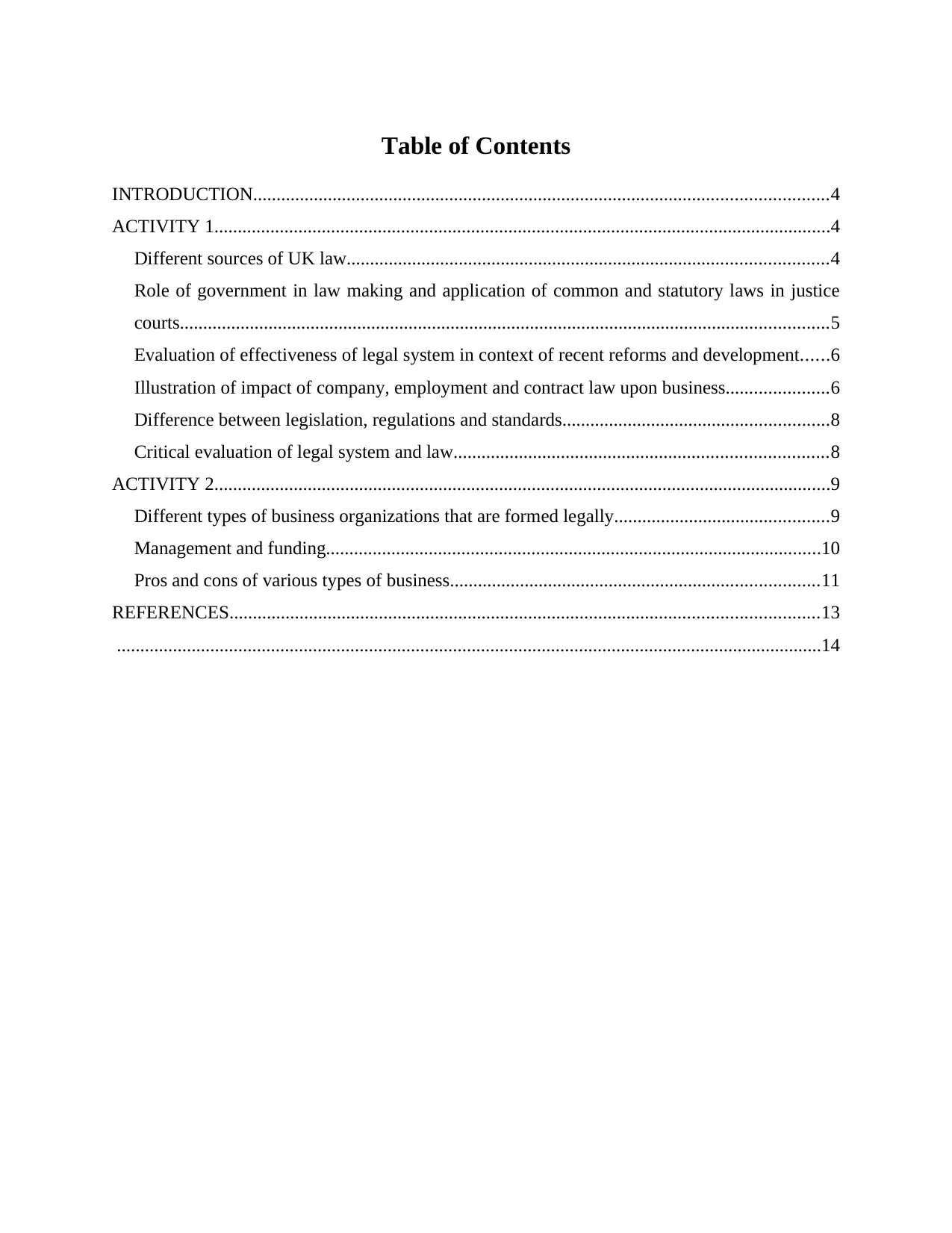
Table of Contents
INTRODUCTION...........................................................................................................................4
ACTIVITY 1....................................................................................................................................4
Different sources of UK law.......................................................................................................4
Role of government in law making and application of common and statutory laws in justice
courts...........................................................................................................................................5
Evaluation of effectiveness of legal system in context of recent reforms and development......6
Illustration of impact of company, employment and contract law upon business......................6
Difference between legislation, regulations and standards.........................................................8
Critical evaluation of legal system and law................................................................................8
ACTIVITY 2....................................................................................................................................9
Different types of business organizations that are formed legally..............................................9
Management and funding..........................................................................................................10
Pros and cons of various types of business...............................................................................11
REFERENCES..............................................................................................................................13
.......................................................................................................................................................14
INTRODUCTION...........................................................................................................................4
ACTIVITY 1....................................................................................................................................4
Different sources of UK law.......................................................................................................4
Role of government in law making and application of common and statutory laws in justice
courts...........................................................................................................................................5
Evaluation of effectiveness of legal system in context of recent reforms and development......6
Illustration of impact of company, employment and contract law upon business......................6
Difference between legislation, regulations and standards.........................................................8
Critical evaluation of legal system and law................................................................................8
ACTIVITY 2....................................................................................................................................9
Different types of business organizations that are formed legally..............................................9
Management and funding..........................................................................................................10
Pros and cons of various types of business...............................................................................11
REFERENCES..............................................................................................................................13
.......................................................................................................................................................14
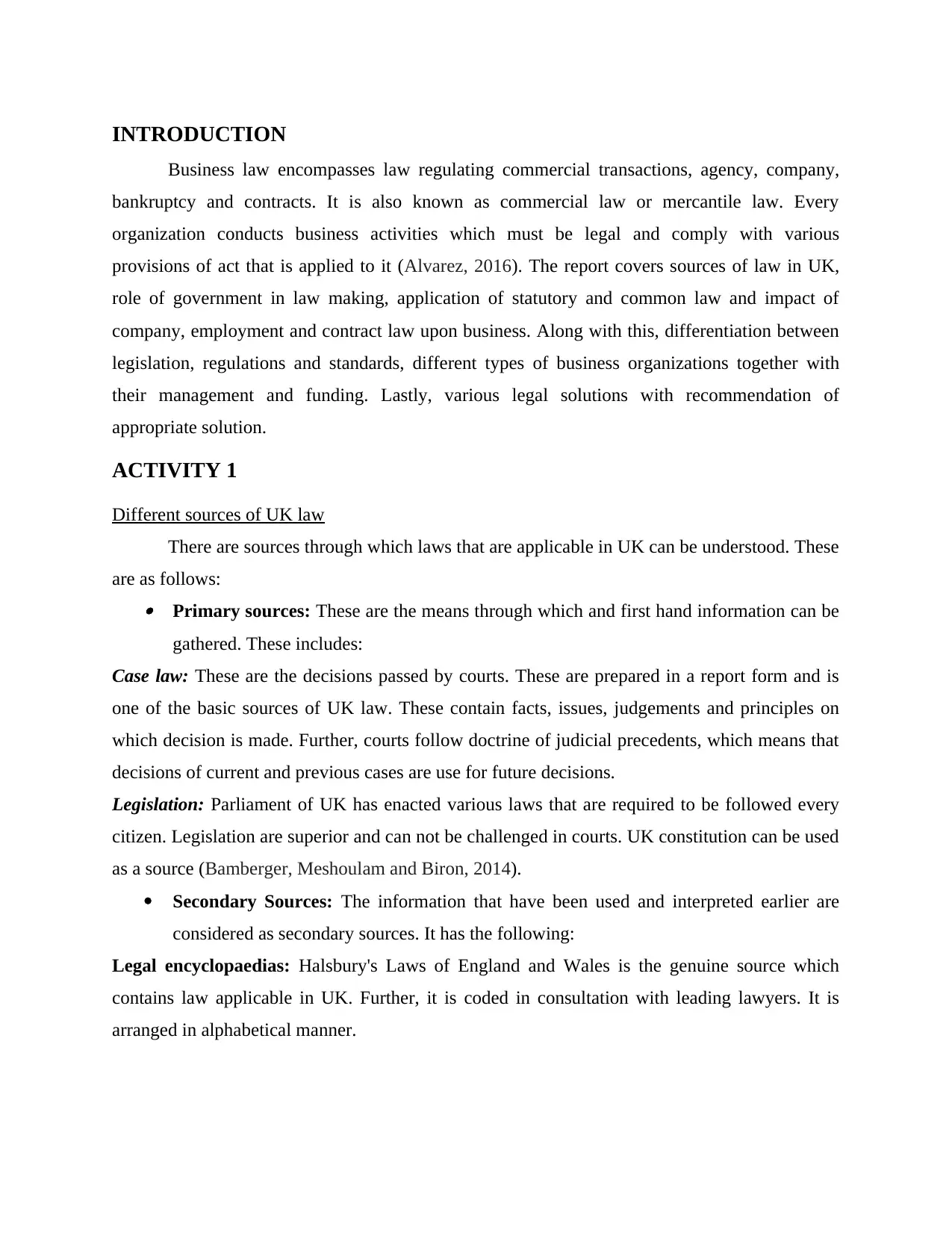
INTRODUCTION
Business law encompasses law regulating commercial transactions, agency, company,
bankruptcy and contracts. It is also known as commercial law or mercantile law. Every
organization conducts business activities which must be legal and comply with various
provisions of act that is applied to it (Alvarez, 2016). The report covers sources of law in UK,
role of government in law making, application of statutory and common law and impact of
company, employment and contract law upon business. Along with this, differentiation between
legislation, regulations and standards, different types of business organizations together with
their management and funding. Lastly, various legal solutions with recommendation of
appropriate solution.
ACTIVITY 1
Different sources of UK law
There are sources through which laws that are applicable in UK can be understood. These
are as follows: Primary sources: These are the means through which and first hand information can be
gathered. These includes:
Case law: These are the decisions passed by courts. These are prepared in a report form and is
one of the basic sources of UK law. These contain facts, issues, judgements and principles on
which decision is made. Further, courts follow doctrine of judicial precedents, which means that
decisions of current and previous cases are use for future decisions.
Legislation: Parliament of UK has enacted various laws that are required to be followed every
citizen. Legislation are superior and can not be challenged in courts. UK constitution can be used
as a source (Bamberger, Meshoulam and Biron, 2014).
Secondary Sources: The information that have been used and interpreted earlier are
considered as secondary sources. It has the following:
Legal encyclopaedias: Halsbury's Laws of England and Wales is the genuine source which
contains law applicable in UK. Further, it is coded in consultation with leading lawyers. It is
arranged in alphabetical manner.
Business law encompasses law regulating commercial transactions, agency, company,
bankruptcy and contracts. It is also known as commercial law or mercantile law. Every
organization conducts business activities which must be legal and comply with various
provisions of act that is applied to it (Alvarez, 2016). The report covers sources of law in UK,
role of government in law making, application of statutory and common law and impact of
company, employment and contract law upon business. Along with this, differentiation between
legislation, regulations and standards, different types of business organizations together with
their management and funding. Lastly, various legal solutions with recommendation of
appropriate solution.
ACTIVITY 1
Different sources of UK law
There are sources through which laws that are applicable in UK can be understood. These
are as follows: Primary sources: These are the means through which and first hand information can be
gathered. These includes:
Case law: These are the decisions passed by courts. These are prepared in a report form and is
one of the basic sources of UK law. These contain facts, issues, judgements and principles on
which decision is made. Further, courts follow doctrine of judicial precedents, which means that
decisions of current and previous cases are use for future decisions.
Legislation: Parliament of UK has enacted various laws that are required to be followed every
citizen. Legislation are superior and can not be challenged in courts. UK constitution can be used
as a source (Bamberger, Meshoulam and Biron, 2014).
Secondary Sources: The information that have been used and interpreted earlier are
considered as secondary sources. It has the following:
Legal encyclopaedias: Halsbury's Laws of England and Wales is the genuine source which
contains law applicable in UK. Further, it is coded in consultation with leading lawyers. It is
arranged in alphabetical manner.
⊘ This is a preview!⊘
Do you want full access?
Subscribe today to unlock all pages.

Trusted by 1+ million students worldwide

Parliamentary publications: To know the history and context of legislation or to understand a
area of law, various publications can be take into account. These include command papers and
debates of House of Commons and House of Lords.
Non-parliamentary publications: These are the reports and consultation papers fro government
departments and agencies. Further, one can access such piece of information from official site of
government department or agency.
Law commission: An independent body has been constituted in the year 1956 to assess and
evaluate existing laws and legal system and make recommendation where amendments are
required (Barbero and et al., 2014). It is a lengthy process under which opinions and suggestions
of interested parties and public are considered.
Law journals: The legal information contain in these journals are exhaustive in nature which
may be categorised into specific or common area of law. Academic arguments may also be there
to enable practitioners and users of law to have updates and amendments.
Textbooks: These are written by authors on legal topics so that students can understood in a
simple language. Along with this, case studies are also a part which helps in knowing the
applicability of a particular legal principle.
Role of government in law making and application of common and statutory laws in justice
courts
Government has a major role in law making process in UK. Further, it has been divided
into three parts and effective co-ordination is vital. They are the one responsible for legal system
and its management in an effective way. The various roles have been discussed below:
Executive role: Government has the responsibility for administration of the state. This
role gives authority for execution, enactment and enforcement of law. The core role is to
effective implementation of legislations so provided. Further, this give power to make
decrees and orders necessary for enforcing law.
Legislative role: The legislative branch of government is divided into two houses viz.
House of Lords and House of Commons (Bhatnagar, 2016). They have a role to draft
bills in order to get royal assent for its applicability as Acts. Further, amendments can
also be made by them to remove loopholes of various laws.
Judicial role: This role is about interpretation of various legislations and constitution.
Further, appointments of judges and judicial members are made by Queen or it can be
area of law, various publications can be take into account. These include command papers and
debates of House of Commons and House of Lords.
Non-parliamentary publications: These are the reports and consultation papers fro government
departments and agencies. Further, one can access such piece of information from official site of
government department or agency.
Law commission: An independent body has been constituted in the year 1956 to assess and
evaluate existing laws and legal system and make recommendation where amendments are
required (Barbero and et al., 2014). It is a lengthy process under which opinions and suggestions
of interested parties and public are considered.
Law journals: The legal information contain in these journals are exhaustive in nature which
may be categorised into specific or common area of law. Academic arguments may also be there
to enable practitioners and users of law to have updates and amendments.
Textbooks: These are written by authors on legal topics so that students can understood in a
simple language. Along with this, case studies are also a part which helps in knowing the
applicability of a particular legal principle.
Role of government in law making and application of common and statutory laws in justice
courts
Government has a major role in law making process in UK. Further, it has been divided
into three parts and effective co-ordination is vital. They are the one responsible for legal system
and its management in an effective way. The various roles have been discussed below:
Executive role: Government has the responsibility for administration of the state. This
role gives authority for execution, enactment and enforcement of law. The core role is to
effective implementation of legislations so provided. Further, this give power to make
decrees and orders necessary for enforcing law.
Legislative role: The legislative branch of government is divided into two houses viz.
House of Lords and House of Commons (Bhatnagar, 2016). They have a role to draft
bills in order to get royal assent for its applicability as Acts. Further, amendments can
also be made by them to remove loopholes of various laws.
Judicial role: This role is about interpretation of various legislations and constitution.
Further, appointments of judges and judicial members are made by Queen or it can be
Paraphrase This Document
Need a fresh take? Get an instant paraphrase of this document with our AI Paraphraser
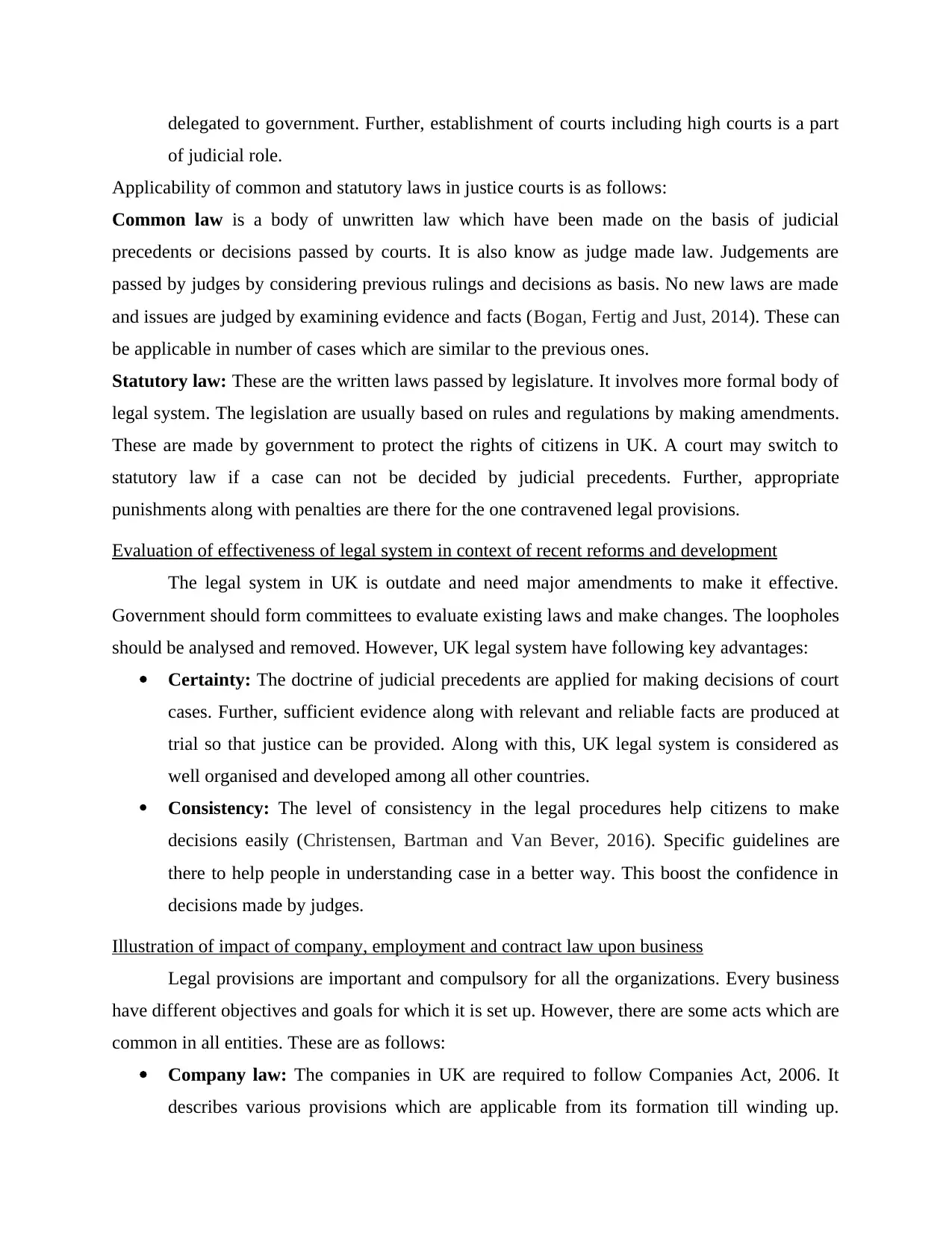
delegated to government. Further, establishment of courts including high courts is a part
of judicial role.
Applicability of common and statutory laws in justice courts is as follows:
Common law is a body of unwritten law which have been made on the basis of judicial
precedents or decisions passed by courts. It is also know as judge made law. Judgements are
passed by judges by considering previous rulings and decisions as basis. No new laws are made
and issues are judged by examining evidence and facts (Bogan, Fertig and Just, 2014). These can
be applicable in number of cases which are similar to the previous ones.
Statutory law: These are the written laws passed by legislature. It involves more formal body of
legal system. The legislation are usually based on rules and regulations by making amendments.
These are made by government to protect the rights of citizens in UK. A court may switch to
statutory law if a case can not be decided by judicial precedents. Further, appropriate
punishments along with penalties are there for the one contravened legal provisions.
Evaluation of effectiveness of legal system in context of recent reforms and development
The legal system in UK is outdate and need major amendments to make it effective.
Government should form committees to evaluate existing laws and make changes. The loopholes
should be analysed and removed. However, UK legal system have following key advantages:
Certainty: The doctrine of judicial precedents are applied for making decisions of court
cases. Further, sufficient evidence along with relevant and reliable facts are produced at
trial so that justice can be provided. Along with this, UK legal system is considered as
well organised and developed among all other countries.
Consistency: The level of consistency in the legal procedures help citizens to make
decisions easily (Christensen, Bartman and Van Bever, 2016). Specific guidelines are
there to help people in understanding case in a better way. This boost the confidence in
decisions made by judges.
Illustration of impact of company, employment and contract law upon business
Legal provisions are important and compulsory for all the organizations. Every business
have different objectives and goals for which it is set up. However, there are some acts which are
common in all entities. These are as follows:
Company law: The companies in UK are required to follow Companies Act, 2006. It
describes various provisions which are applicable from its formation till winding up.
of judicial role.
Applicability of common and statutory laws in justice courts is as follows:
Common law is a body of unwritten law which have been made on the basis of judicial
precedents or decisions passed by courts. It is also know as judge made law. Judgements are
passed by judges by considering previous rulings and decisions as basis. No new laws are made
and issues are judged by examining evidence and facts (Bogan, Fertig and Just, 2014). These can
be applicable in number of cases which are similar to the previous ones.
Statutory law: These are the written laws passed by legislature. It involves more formal body of
legal system. The legislation are usually based on rules and regulations by making amendments.
These are made by government to protect the rights of citizens in UK. A court may switch to
statutory law if a case can not be decided by judicial precedents. Further, appropriate
punishments along with penalties are there for the one contravened legal provisions.
Evaluation of effectiveness of legal system in context of recent reforms and development
The legal system in UK is outdate and need major amendments to make it effective.
Government should form committees to evaluate existing laws and make changes. The loopholes
should be analysed and removed. However, UK legal system have following key advantages:
Certainty: The doctrine of judicial precedents are applied for making decisions of court
cases. Further, sufficient evidence along with relevant and reliable facts are produced at
trial so that justice can be provided. Along with this, UK legal system is considered as
well organised and developed among all other countries.
Consistency: The level of consistency in the legal procedures help citizens to make
decisions easily (Christensen, Bartman and Van Bever, 2016). Specific guidelines are
there to help people in understanding case in a better way. This boost the confidence in
decisions made by judges.
Illustration of impact of company, employment and contract law upon business
Legal provisions are important and compulsory for all the organizations. Every business
have different objectives and goals for which it is set up. However, there are some acts which are
common in all entities. These are as follows:
Company law: The companies in UK are required to follow Companies Act, 2006. It
describes various provisions which are applicable from its formation till winding up.

There are rules which are added as and when amendments takes place. It contains laws
governing establishment, management, funding, directors, shareholders, resignation or
removal etc. Along with this, offences and related term with penalties are also mentioned
in the Act. A company can not be incorporated without fulfilling requirements of this act.
Further, huge financial loss can be caused in legal consequences (Collis, Holt and
Hussey, 2017). In extreme case, it may be wound up. Along with this, amendments on a
timely basis must be taken into account for conducting business affairs in an organized
way. For example, company has failed to remove director who has failed to disclose his
interest in the contracts as per Companies Act, 2006. Then company will be liable to pay
hefty fines.
Employment law: The laws relating to employees are required to be abide by all the
organizations as they are key resources for all the entities. Employment Act, 2002 is
applicable to protect personnels from discrimination. Further, it imposes a legal
requirement for employers to provide safety and healthy working environment. It has
provisions regarding appointment, working conditions, minimum salary or wages,
working hours, incentives, dismissal etc. No work will be conducted without employees.
Candidates prefer those organizations which treat its employees equally and fairly.
Hence, in case of non-compliance of this act, entities will face huge crisis in
sustainability because no person would be interested in joining it. Employment tribunals
are there where case can be filed against employers if injustice have been encountered
(Dodd and Hanna, 2018). For example, an employee has been removed without proper
procedure being followed and no justification was provided. In such a case, strict legal
action will be taken which will ruin entity's image.
Contract law: These govern commercial transactions that resulted from various contracts
made between buyer and sellers. An agreement made with terms and conditions, legal
intention with a consideration which is enforceable by law is called contract. In UK,
contracts are governed through Sale of Supply of Goods Act, 1994. These regulate all
agreements and contracts formed in the ordinary course of business. In the case of breach
of a term, one may seek specific legal remedy or action. These laws are the basis on
which outside parties enters into contracts, and in absence of such law, entities will not be
able to carry its business. It has to execute contracts with suppliers, employees,
governing establishment, management, funding, directors, shareholders, resignation or
removal etc. Along with this, offences and related term with penalties are also mentioned
in the Act. A company can not be incorporated without fulfilling requirements of this act.
Further, huge financial loss can be caused in legal consequences (Collis, Holt and
Hussey, 2017). In extreme case, it may be wound up. Along with this, amendments on a
timely basis must be taken into account for conducting business affairs in an organized
way. For example, company has failed to remove director who has failed to disclose his
interest in the contracts as per Companies Act, 2006. Then company will be liable to pay
hefty fines.
Employment law: The laws relating to employees are required to be abide by all the
organizations as they are key resources for all the entities. Employment Act, 2002 is
applicable to protect personnels from discrimination. Further, it imposes a legal
requirement for employers to provide safety and healthy working environment. It has
provisions regarding appointment, working conditions, minimum salary or wages,
working hours, incentives, dismissal etc. No work will be conducted without employees.
Candidates prefer those organizations which treat its employees equally and fairly.
Hence, in case of non-compliance of this act, entities will face huge crisis in
sustainability because no person would be interested in joining it. Employment tribunals
are there where case can be filed against employers if injustice have been encountered
(Dodd and Hanna, 2018). For example, an employee has been removed without proper
procedure being followed and no justification was provided. In such a case, strict legal
action will be taken which will ruin entity's image.
Contract law: These govern commercial transactions that resulted from various contracts
made between buyer and sellers. An agreement made with terms and conditions, legal
intention with a consideration which is enforceable by law is called contract. In UK,
contracts are governed through Sale of Supply of Goods Act, 1994. These regulate all
agreements and contracts formed in the ordinary course of business. In the case of breach
of a term, one may seek specific legal remedy or action. These laws are the basis on
which outside parties enters into contracts, and in absence of such law, entities will not be
able to carry its business. It has to execute contracts with suppliers, employees,
⊘ This is a preview!⊘
Do you want full access?
Subscribe today to unlock all pages.

Trusted by 1+ million students worldwide
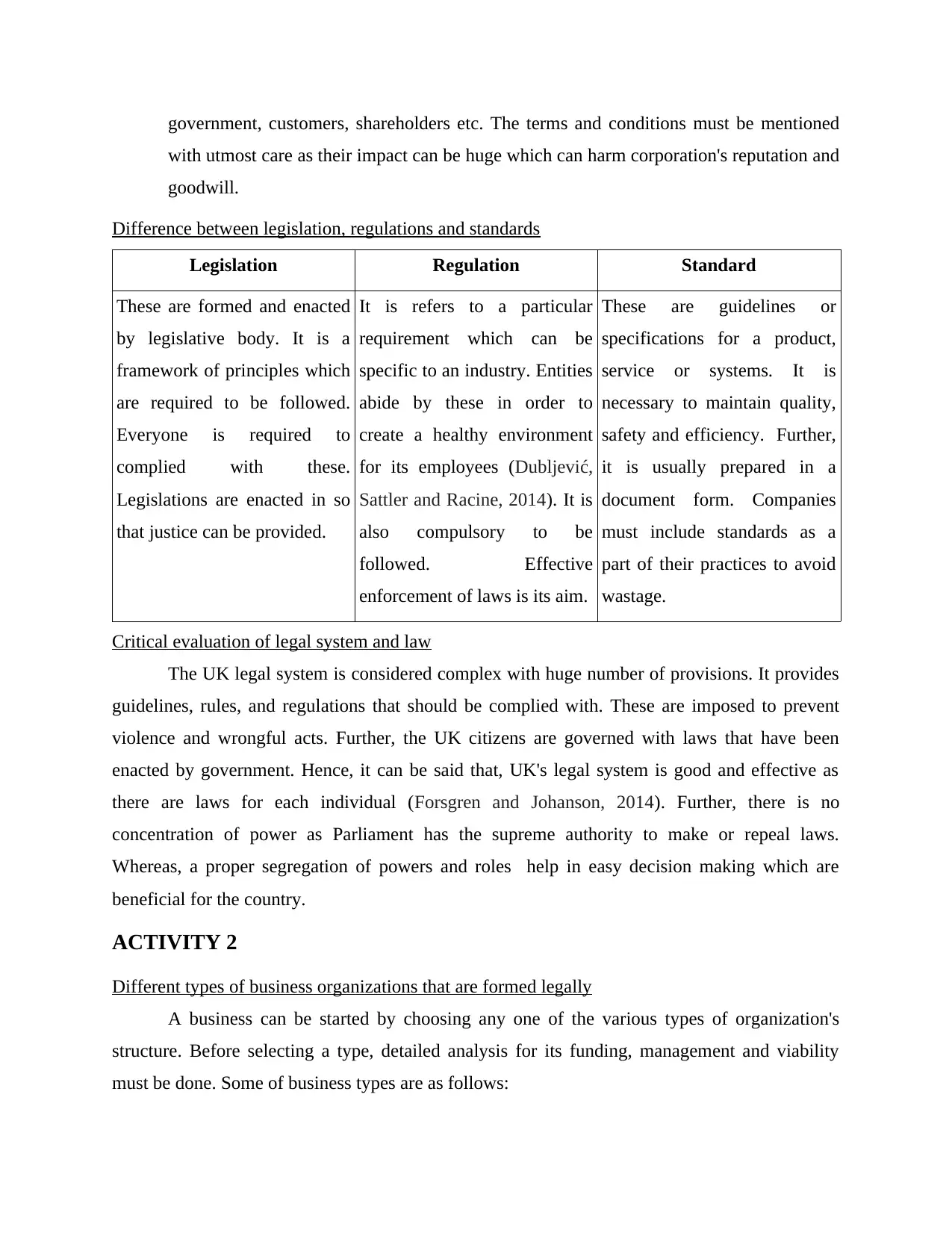
government, customers, shareholders etc. The terms and conditions must be mentioned
with utmost care as their impact can be huge which can harm corporation's reputation and
goodwill.
Difference between legislation, regulations and standards
Legislation Regulation Standard
These are formed and enacted
by legislative body. It is a
framework of principles which
are required to be followed.
Everyone is required to
complied with these.
Legislations are enacted in so
that justice can be provided.
It is refers to a particular
requirement which can be
specific to an industry. Entities
abide by these in order to
create a healthy environment
for its employees (Dubljević,
Sattler and Racine, 2014). It is
also compulsory to be
followed. Effective
enforcement of laws is its aim.
These are guidelines or
specifications for a product,
service or systems. It is
necessary to maintain quality,
safety and efficiency. Further,
it is usually prepared in a
document form. Companies
must include standards as a
part of their practices to avoid
wastage.
Critical evaluation of legal system and law
The UK legal system is considered complex with huge number of provisions. It provides
guidelines, rules, and regulations that should be complied with. These are imposed to prevent
violence and wrongful acts. Further, the UK citizens are governed with laws that have been
enacted by government. Hence, it can be said that, UK's legal system is good and effective as
there are laws for each individual (Forsgren and Johanson, 2014). Further, there is no
concentration of power as Parliament has the supreme authority to make or repeal laws.
Whereas, a proper segregation of powers and roles help in easy decision making which are
beneficial for the country.
ACTIVITY 2
Different types of business organizations that are formed legally
A business can be started by choosing any one of the various types of organization's
structure. Before selecting a type, detailed analysis for its funding, management and viability
must be done. Some of business types are as follows:
with utmost care as their impact can be huge which can harm corporation's reputation and
goodwill.
Difference between legislation, regulations and standards
Legislation Regulation Standard
These are formed and enacted
by legislative body. It is a
framework of principles which
are required to be followed.
Everyone is required to
complied with these.
Legislations are enacted in so
that justice can be provided.
It is refers to a particular
requirement which can be
specific to an industry. Entities
abide by these in order to
create a healthy environment
for its employees (Dubljević,
Sattler and Racine, 2014). It is
also compulsory to be
followed. Effective
enforcement of laws is its aim.
These are guidelines or
specifications for a product,
service or systems. It is
necessary to maintain quality,
safety and efficiency. Further,
it is usually prepared in a
document form. Companies
must include standards as a
part of their practices to avoid
wastage.
Critical evaluation of legal system and law
The UK legal system is considered complex with huge number of provisions. It provides
guidelines, rules, and regulations that should be complied with. These are imposed to prevent
violence and wrongful acts. Further, the UK citizens are governed with laws that have been
enacted by government. Hence, it can be said that, UK's legal system is good and effective as
there are laws for each individual (Forsgren and Johanson, 2014). Further, there is no
concentration of power as Parliament has the supreme authority to make or repeal laws.
Whereas, a proper segregation of powers and roles help in easy decision making which are
beneficial for the country.
ACTIVITY 2
Different types of business organizations that are formed legally
A business can be started by choosing any one of the various types of organization's
structure. Before selecting a type, detailed analysis for its funding, management and viability
must be done. Some of business types are as follows:
Paraphrase This Document
Need a fresh take? Get an instant paraphrase of this document with our AI Paraphraser
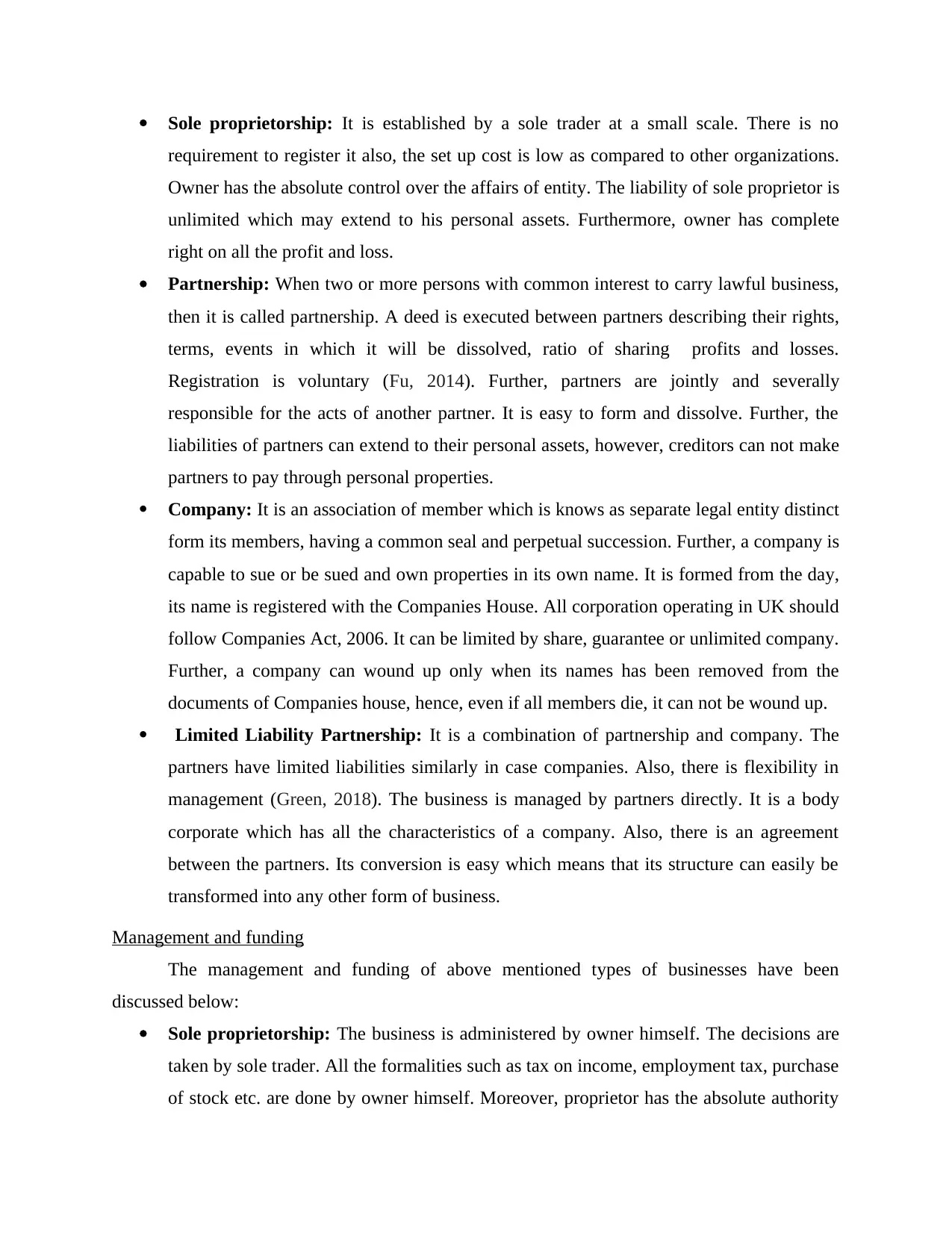
Sole proprietorship: It is established by a sole trader at a small scale. There is no
requirement to register it also, the set up cost is low as compared to other organizations.
Owner has the absolute control over the affairs of entity. The liability of sole proprietor is
unlimited which may extend to his personal assets. Furthermore, owner has complete
right on all the profit and loss.
Partnership: When two or more persons with common interest to carry lawful business,
then it is called partnership. A deed is executed between partners describing their rights,
terms, events in which it will be dissolved, ratio of sharing profits and losses.
Registration is voluntary (Fu, 2014). Further, partners are jointly and severally
responsible for the acts of another partner. It is easy to form and dissolve. Further, the
liabilities of partners can extend to their personal assets, however, creditors can not make
partners to pay through personal properties.
Company: It is an association of member which is knows as separate legal entity distinct
form its members, having a common seal and perpetual succession. Further, a company is
capable to sue or be sued and own properties in its own name. It is formed from the day,
its name is registered with the Companies House. All corporation operating in UK should
follow Companies Act, 2006. It can be limited by share, guarantee or unlimited company.
Further, a company can wound up only when its names has been removed from the
documents of Companies house, hence, even if all members die, it can not be wound up.
Limited Liability Partnership: It is a combination of partnership and company. The
partners have limited liabilities similarly in case companies. Also, there is flexibility in
management (Green, 2018). The business is managed by partners directly. It is a body
corporate which has all the characteristics of a company. Also, there is an agreement
between the partners. Its conversion is easy which means that its structure can easily be
transformed into any other form of business.
Management and funding
The management and funding of above mentioned types of businesses have been
discussed below:
Sole proprietorship: The business is administered by owner himself. The decisions are
taken by sole trader. All the formalities such as tax on income, employment tax, purchase
of stock etc. are done by owner himself. Moreover, proprietor has the absolute authority
requirement to register it also, the set up cost is low as compared to other organizations.
Owner has the absolute control over the affairs of entity. The liability of sole proprietor is
unlimited which may extend to his personal assets. Furthermore, owner has complete
right on all the profit and loss.
Partnership: When two or more persons with common interest to carry lawful business,
then it is called partnership. A deed is executed between partners describing their rights,
terms, events in which it will be dissolved, ratio of sharing profits and losses.
Registration is voluntary (Fu, 2014). Further, partners are jointly and severally
responsible for the acts of another partner. It is easy to form and dissolve. Further, the
liabilities of partners can extend to their personal assets, however, creditors can not make
partners to pay through personal properties.
Company: It is an association of member which is knows as separate legal entity distinct
form its members, having a common seal and perpetual succession. Further, a company is
capable to sue or be sued and own properties in its own name. It is formed from the day,
its name is registered with the Companies House. All corporation operating in UK should
follow Companies Act, 2006. It can be limited by share, guarantee or unlimited company.
Further, a company can wound up only when its names has been removed from the
documents of Companies house, hence, even if all members die, it can not be wound up.
Limited Liability Partnership: It is a combination of partnership and company. The
partners have limited liabilities similarly in case companies. Also, there is flexibility in
management (Green, 2018). The business is managed by partners directly. It is a body
corporate which has all the characteristics of a company. Also, there is an agreement
between the partners. Its conversion is easy which means that its structure can easily be
transformed into any other form of business.
Management and funding
The management and funding of above mentioned types of businesses have been
discussed below:
Sole proprietorship: The business is administered by owner himself. The decisions are
taken by sole trader. All the formalities such as tax on income, employment tax, purchase
of stock etc. are done by owner himself. Moreover, proprietor has the absolute authority
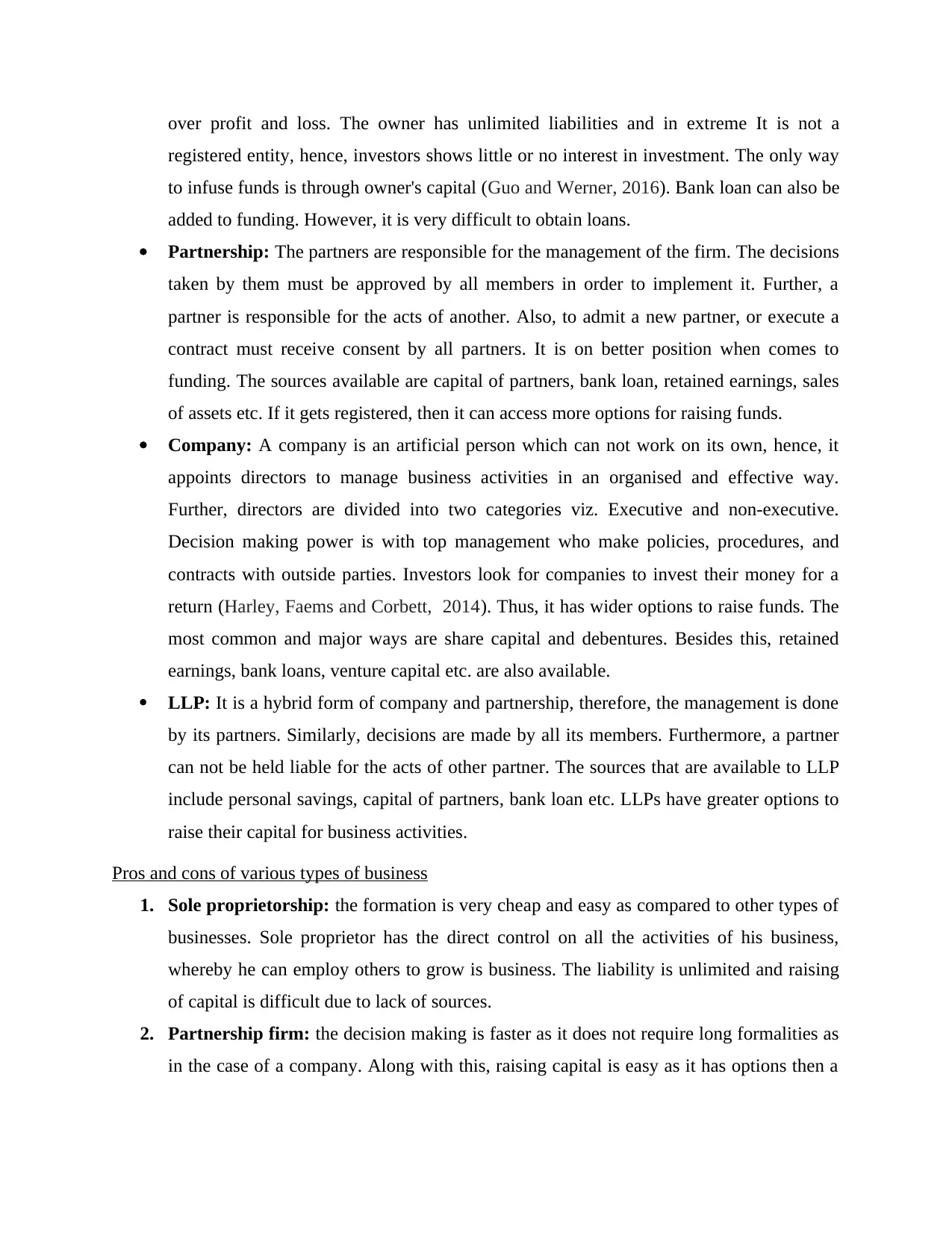
over profit and loss. The owner has unlimited liabilities and in extreme It is not a
registered entity, hence, investors shows little or no interest in investment. The only way
to infuse funds is through owner's capital (Guo and Werner, 2016). Bank loan can also be
added to funding. However, it is very difficult to obtain loans.
Partnership: The partners are responsible for the management of the firm. The decisions
taken by them must be approved by all members in order to implement it. Further, a
partner is responsible for the acts of another. Also, to admit a new partner, or execute a
contract must receive consent by all partners. It is on better position when comes to
funding. The sources available are capital of partners, bank loan, retained earnings, sales
of assets etc. If it gets registered, then it can access more options for raising funds.
Company: A company is an artificial person which can not work on its own, hence, it
appoints directors to manage business activities in an organised and effective way.
Further, directors are divided into two categories viz. Executive and non-executive.
Decision making power is with top management who make policies, procedures, and
contracts with outside parties. Investors look for companies to invest their money for a
return (Harley, Faems and Corbett, 2014). Thus, it has wider options to raise funds. The
most common and major ways are share capital and debentures. Besides this, retained
earnings, bank loans, venture capital etc. are also available.
LLP: It is a hybrid form of company and partnership, therefore, the management is done
by its partners. Similarly, decisions are made by all its members. Furthermore, a partner
can not be held liable for the acts of other partner. The sources that are available to LLP
include personal savings, capital of partners, bank loan etc. LLPs have greater options to
raise their capital for business activities.
Pros and cons of various types of business
1. Sole proprietorship: the formation is very cheap and easy as compared to other types of
businesses. Sole proprietor has the direct control on all the activities of his business,
whereby he can employ others to grow is business. The liability is unlimited and raising
of capital is difficult due to lack of sources.
2. Partnership firm: the decision making is faster as it does not require long formalities as
in the case of a company. Along with this, raising capital is easy as it has options then a
registered entity, hence, investors shows little or no interest in investment. The only way
to infuse funds is through owner's capital (Guo and Werner, 2016). Bank loan can also be
added to funding. However, it is very difficult to obtain loans.
Partnership: The partners are responsible for the management of the firm. The decisions
taken by them must be approved by all members in order to implement it. Further, a
partner is responsible for the acts of another. Also, to admit a new partner, or execute a
contract must receive consent by all partners. It is on better position when comes to
funding. The sources available are capital of partners, bank loan, retained earnings, sales
of assets etc. If it gets registered, then it can access more options for raising funds.
Company: A company is an artificial person which can not work on its own, hence, it
appoints directors to manage business activities in an organised and effective way.
Further, directors are divided into two categories viz. Executive and non-executive.
Decision making power is with top management who make policies, procedures, and
contracts with outside parties. Investors look for companies to invest their money for a
return (Harley, Faems and Corbett, 2014). Thus, it has wider options to raise funds. The
most common and major ways are share capital and debentures. Besides this, retained
earnings, bank loans, venture capital etc. are also available.
LLP: It is a hybrid form of company and partnership, therefore, the management is done
by its partners. Similarly, decisions are made by all its members. Furthermore, a partner
can not be held liable for the acts of other partner. The sources that are available to LLP
include personal savings, capital of partners, bank loan etc. LLPs have greater options to
raise their capital for business activities.
Pros and cons of various types of business
1. Sole proprietorship: the formation is very cheap and easy as compared to other types of
businesses. Sole proprietor has the direct control on all the activities of his business,
whereby he can employ others to grow is business. The liability is unlimited and raising
of capital is difficult due to lack of sources.
2. Partnership firm: the decision making is faster as it does not require long formalities as
in the case of a company. Along with this, raising capital is easy as it has options then a
⊘ This is a preview!⊘
Do you want full access?
Subscribe today to unlock all pages.

Trusted by 1+ million students worldwide
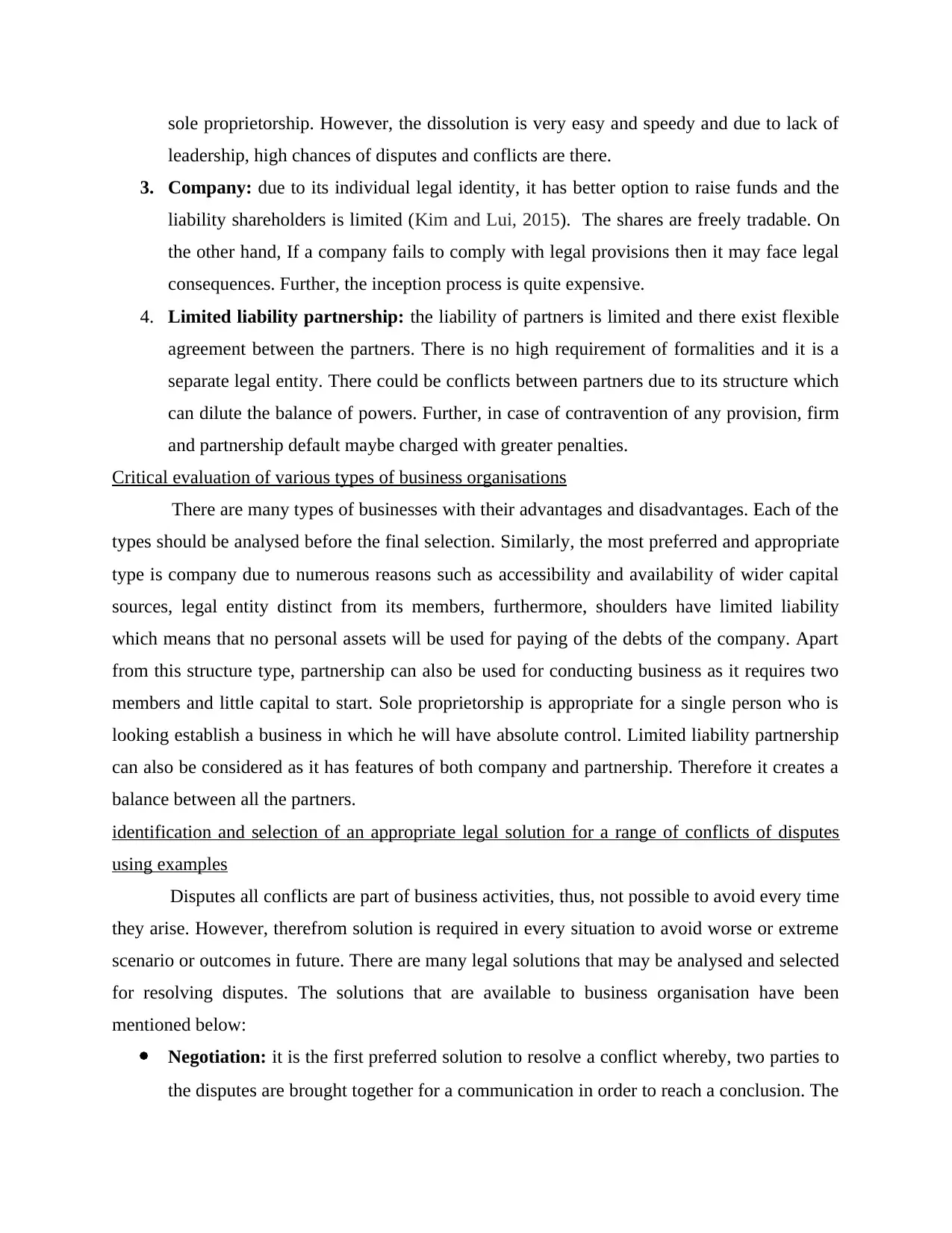
sole proprietorship. However, the dissolution is very easy and speedy and due to lack of
leadership, high chances of disputes and conflicts are there.
3. Company: due to its individual legal identity, it has better option to raise funds and the
liability shareholders is limited (Kim and Lui, 2015). The shares are freely tradable. On
the other hand, If a company fails to comply with legal provisions then it may face legal
consequences. Further, the inception process is quite expensive.
4. Limited liability partnership: the liability of partners is limited and there exist flexible
agreement between the partners. There is no high requirement of formalities and it is a
separate legal entity. There could be conflicts between partners due to its structure which
can dilute the balance of powers. Further, in case of contravention of any provision, firm
and partnership default maybe charged with greater penalties.
Critical evaluation of various types of business organisations
There are many types of businesses with their advantages and disadvantages. Each of the
types should be analysed before the final selection. Similarly, the most preferred and appropriate
type is company due to numerous reasons such as accessibility and availability of wider capital
sources, legal entity distinct from its members, furthermore, shoulders have limited liability
which means that no personal assets will be used for paying of the debts of the company. Apart
from this structure type, partnership can also be used for conducting business as it requires two
members and little capital to start. Sole proprietorship is appropriate for a single person who is
looking establish a business in which he will have absolute control. Limited liability partnership
can also be considered as it has features of both company and partnership. Therefore it creates a
balance between all the partners.
identification and selection of an appropriate legal solution for a range of conflicts of disputes
using examples
Disputes all conflicts are part of business activities, thus, not possible to avoid every time
they arise. However, therefrom solution is required in every situation to avoid worse or extreme
scenario or outcomes in future. There are many legal solutions that may be analysed and selected
for resolving disputes. The solutions that are available to business organisation have been
mentioned below:
Negotiation: it is the first preferred solution to resolve a conflict whereby, two parties to
the disputes are brought together for a communication in order to reach a conclusion. The
leadership, high chances of disputes and conflicts are there.
3. Company: due to its individual legal identity, it has better option to raise funds and the
liability shareholders is limited (Kim and Lui, 2015). The shares are freely tradable. On
the other hand, If a company fails to comply with legal provisions then it may face legal
consequences. Further, the inception process is quite expensive.
4. Limited liability partnership: the liability of partners is limited and there exist flexible
agreement between the partners. There is no high requirement of formalities and it is a
separate legal entity. There could be conflicts between partners due to its structure which
can dilute the balance of powers. Further, in case of contravention of any provision, firm
and partnership default maybe charged with greater penalties.
Critical evaluation of various types of business organisations
There are many types of businesses with their advantages and disadvantages. Each of the
types should be analysed before the final selection. Similarly, the most preferred and appropriate
type is company due to numerous reasons such as accessibility and availability of wider capital
sources, legal entity distinct from its members, furthermore, shoulders have limited liability
which means that no personal assets will be used for paying of the debts of the company. Apart
from this structure type, partnership can also be used for conducting business as it requires two
members and little capital to start. Sole proprietorship is appropriate for a single person who is
looking establish a business in which he will have absolute control. Limited liability partnership
can also be considered as it has features of both company and partnership. Therefore it creates a
balance between all the partners.
identification and selection of an appropriate legal solution for a range of conflicts of disputes
using examples
Disputes all conflicts are part of business activities, thus, not possible to avoid every time
they arise. However, therefrom solution is required in every situation to avoid worse or extreme
scenario or outcomes in future. There are many legal solutions that may be analysed and selected
for resolving disputes. The solutions that are available to business organisation have been
mentioned below:
Negotiation: it is the first preferred solution to resolve a conflict whereby, two parties to
the disputes are brought together for a communication in order to reach a conclusion. The
Paraphrase This Document
Need a fresh take? Get an instant paraphrase of this document with our AI Paraphraser
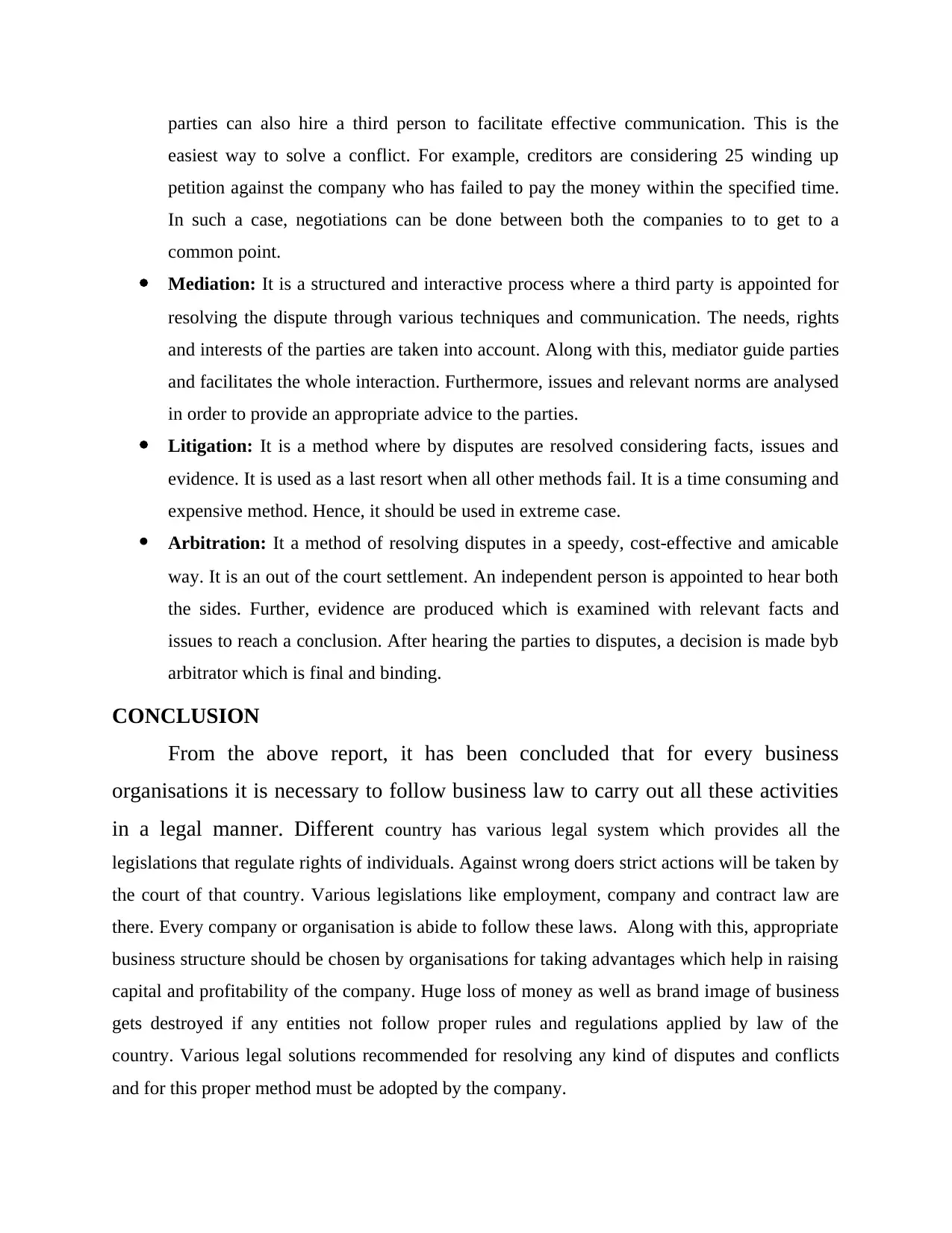
parties can also hire a third person to facilitate effective communication. This is the
easiest way to solve a conflict. For example, creditors are considering 25 winding up
petition against the company who has failed to pay the money within the specified time.
In such a case, negotiations can be done between both the companies to to get to a
common point.
Mediation: It is a structured and interactive process where a third party is appointed for
resolving the dispute through various techniques and communication. The needs, rights
and interests of the parties are taken into account. Along with this, mediator guide parties
and facilitates the whole interaction. Furthermore, issues and relevant norms are analysed
in order to provide an appropriate advice to the parties.
Litigation: It is a method where by disputes are resolved considering facts, issues and
evidence. It is used as a last resort when all other methods fail. It is a time consuming and
expensive method. Hence, it should be used in extreme case.
Arbitration: It a method of resolving disputes in a speedy, cost-effective and amicable
way. It is an out of the court settlement. An independent person is appointed to hear both
the sides. Further, evidence are produced which is examined with relevant facts and
issues to reach a conclusion. After hearing the parties to disputes, a decision is made byb
arbitrator which is final and binding.
CONCLUSION
From the above report, it has been concluded that for every business
organisations it is necessary to follow business law to carry out all these activities
in a legal manner. Different country has various legal system which provides all the
legislations that regulate rights of individuals. Against wrong doers strict actions will be taken by
the court of that country. Various legislations like employment, company and contract law are
there. Every company or organisation is abide to follow these laws. Along with this, appropriate
business structure should be chosen by organisations for taking advantages which help in raising
capital and profitability of the company. Huge loss of money as well as brand image of business
gets destroyed if any entities not follow proper rules and regulations applied by law of the
country. Various legal solutions recommended for resolving any kind of disputes and conflicts
and for this proper method must be adopted by the company.
easiest way to solve a conflict. For example, creditors are considering 25 winding up
petition against the company who has failed to pay the money within the specified time.
In such a case, negotiations can be done between both the companies to to get to a
common point.
Mediation: It is a structured and interactive process where a third party is appointed for
resolving the dispute through various techniques and communication. The needs, rights
and interests of the parties are taken into account. Along with this, mediator guide parties
and facilitates the whole interaction. Furthermore, issues and relevant norms are analysed
in order to provide an appropriate advice to the parties.
Litigation: It is a method where by disputes are resolved considering facts, issues and
evidence. It is used as a last resort when all other methods fail. It is a time consuming and
expensive method. Hence, it should be used in extreme case.
Arbitration: It a method of resolving disputes in a speedy, cost-effective and amicable
way. It is an out of the court settlement. An independent person is appointed to hear both
the sides. Further, evidence are produced which is examined with relevant facts and
issues to reach a conclusion. After hearing the parties to disputes, a decision is made byb
arbitrator which is final and binding.
CONCLUSION
From the above report, it has been concluded that for every business
organisations it is necessary to follow business law to carry out all these activities
in a legal manner. Different country has various legal system which provides all the
legislations that regulate rights of individuals. Against wrong doers strict actions will be taken by
the court of that country. Various legislations like employment, company and contract law are
there. Every company or organisation is abide to follow these laws. Along with this, appropriate
business structure should be chosen by organisations for taking advantages which help in raising
capital and profitability of the company. Huge loss of money as well as brand image of business
gets destroyed if any entities not follow proper rules and regulations applied by law of the
country. Various legal solutions recommended for resolving any kind of disputes and conflicts
and for this proper method must be adopted by the company.

REFERENCES
Books and Journals:
Alvarez, J. L. ed., 2016. The diffusion and consumption of business knowledge. Springer.
Bamberger, P. A., Meshoulam, I. and Biron, M., 2014. Human resource strategy: Formulation,
implementation, and impact. Routledge.
Barbero, J. L., and et al., 2014. Do different types of incubators produce different types of
innovations?. The Journal of Technology Transfer. 39(2). pp.151-168.
Bhatnagar, A. ed., 2016. Lightweight ballistic composites: military and law-enforcement
applications. Woodhead Publishing.
Bogan, V. L., Fertig, A. R. and Just, D. R., 2014. Self-employment and mental health.
Christensen, C. M., Bartman, T. and Van Bever, D., 2016. The hard truth about business model
innovation. MIT Sloan Management Review. 58(1). p.31.
Collis, J., Holt, A. and Hussey, R., 2017. Business accounting. Palgrave.
Dodd, M. and Hanna, M., 2018. McNae's essential law for journalists. Oxford University Press.
Dubljević, V., Sattler, S. and Racine, É., 2014. Cognitive enhancement and academic
misconduct: a study exploring their frequency and relationship. Ethics &
Behavior, 24(5), pp.408-420.
Forsgren, M. and Johanson, J., 2014. Managing networks in international business. Routledge.
Fu, W., 2014. The impact of emotional intelligence, organizational commitment, and job
satisfaction on ethical behavior of Chinese employees. Journal of Business
Ethics. 122(1). pp.137-144.
Green, L. C., 2018. The contemporary law of armed conflict.
Guo, X. and Werner, J. M., 2016. Gender, family and business: an empirical study of
incorporated self-employed individuals in the US. International Journal of Gender and
Entrepreneurship. 8(4). pp.373-401.
Harley, B., Faems, D. and Corbett, A., 2014. A few bad apples or the tip of an iceberg?
Academic misconduct in publishing. Journal of Management Studies. 51(8). pp.1361-
1363.
Kim, Y. and Lui, S. S., 2015. The impacts of external network and business group on innovation:
Do the types of innovation matter?. Journal of Business Research. 68(9). pp.1964-1973.
Liao, Q. J and et al., 2018. Perceptions of Chinese biomedical researchers towards academic
misconduct: a comparison between 2015 and 2010. Science and engineering ethics.
pp.1-17.
Macfarlane, B., Zhang, J. and Pun, A., 2014. Academic integrity: a review of the
literature. Studies in Higher Education. 39(2). pp.339-358.
Niskanen, J., 2017. Bureaucracy and representative government. Routledge.
Purce, J., 2014. The impact of corporate strategy on human resource management. New
Perspectives on Human Resource Management (Routledge Revivals), 67.
Savage, M and et al., 2014. Property Bureaucracy & Culture: Middle Class Formation in
Contemporary Britain. Routledge.
Sekaran, U. and Bougie, R., 2016. Research methods for business: A skill building approach.
John Wiley & Sons.
Shenkar, O., Luo, Y. and Chi, T., 2014. International business. Routledge.
Storey, D.J., 2016. Understanding the small business sector. Routledge.
Books and Journals:
Alvarez, J. L. ed., 2016. The diffusion and consumption of business knowledge. Springer.
Bamberger, P. A., Meshoulam, I. and Biron, M., 2014. Human resource strategy: Formulation,
implementation, and impact. Routledge.
Barbero, J. L., and et al., 2014. Do different types of incubators produce different types of
innovations?. The Journal of Technology Transfer. 39(2). pp.151-168.
Bhatnagar, A. ed., 2016. Lightweight ballistic composites: military and law-enforcement
applications. Woodhead Publishing.
Bogan, V. L., Fertig, A. R. and Just, D. R., 2014. Self-employment and mental health.
Christensen, C. M., Bartman, T. and Van Bever, D., 2016. The hard truth about business model
innovation. MIT Sloan Management Review. 58(1). p.31.
Collis, J., Holt, A. and Hussey, R., 2017. Business accounting. Palgrave.
Dodd, M. and Hanna, M., 2018. McNae's essential law for journalists. Oxford University Press.
Dubljević, V., Sattler, S. and Racine, É., 2014. Cognitive enhancement and academic
misconduct: a study exploring their frequency and relationship. Ethics &
Behavior, 24(5), pp.408-420.
Forsgren, M. and Johanson, J., 2014. Managing networks in international business. Routledge.
Fu, W., 2014. The impact of emotional intelligence, organizational commitment, and job
satisfaction on ethical behavior of Chinese employees. Journal of Business
Ethics. 122(1). pp.137-144.
Green, L. C., 2018. The contemporary law of armed conflict.
Guo, X. and Werner, J. M., 2016. Gender, family and business: an empirical study of
incorporated self-employed individuals in the US. International Journal of Gender and
Entrepreneurship. 8(4). pp.373-401.
Harley, B., Faems, D. and Corbett, A., 2014. A few bad apples or the tip of an iceberg?
Academic misconduct in publishing. Journal of Management Studies. 51(8). pp.1361-
1363.
Kim, Y. and Lui, S. S., 2015. The impacts of external network and business group on innovation:
Do the types of innovation matter?. Journal of Business Research. 68(9). pp.1964-1973.
Liao, Q. J and et al., 2018. Perceptions of Chinese biomedical researchers towards academic
misconduct: a comparison between 2015 and 2010. Science and engineering ethics.
pp.1-17.
Macfarlane, B., Zhang, J. and Pun, A., 2014. Academic integrity: a review of the
literature. Studies in Higher Education. 39(2). pp.339-358.
Niskanen, J., 2017. Bureaucracy and representative government. Routledge.
Purce, J., 2014. The impact of corporate strategy on human resource management. New
Perspectives on Human Resource Management (Routledge Revivals), 67.
Savage, M and et al., 2014. Property Bureaucracy & Culture: Middle Class Formation in
Contemporary Britain. Routledge.
Sekaran, U. and Bougie, R., 2016. Research methods for business: A skill building approach.
John Wiley & Sons.
Shenkar, O., Luo, Y. and Chi, T., 2014. International business. Routledge.
Storey, D.J., 2016. Understanding the small business sector. Routledge.
⊘ This is a preview!⊘
Do you want full access?
Subscribe today to unlock all pages.

Trusted by 1+ million students worldwide
1 out of 13
Related Documents
Your All-in-One AI-Powered Toolkit for Academic Success.
+13062052269
info@desklib.com
Available 24*7 on WhatsApp / Email
![[object Object]](/_next/static/media/star-bottom.7253800d.svg)
Unlock your academic potential
Copyright © 2020–2025 A2Z Services. All Rights Reserved. Developed and managed by ZUCOL.





